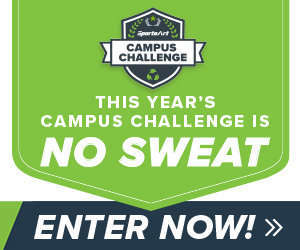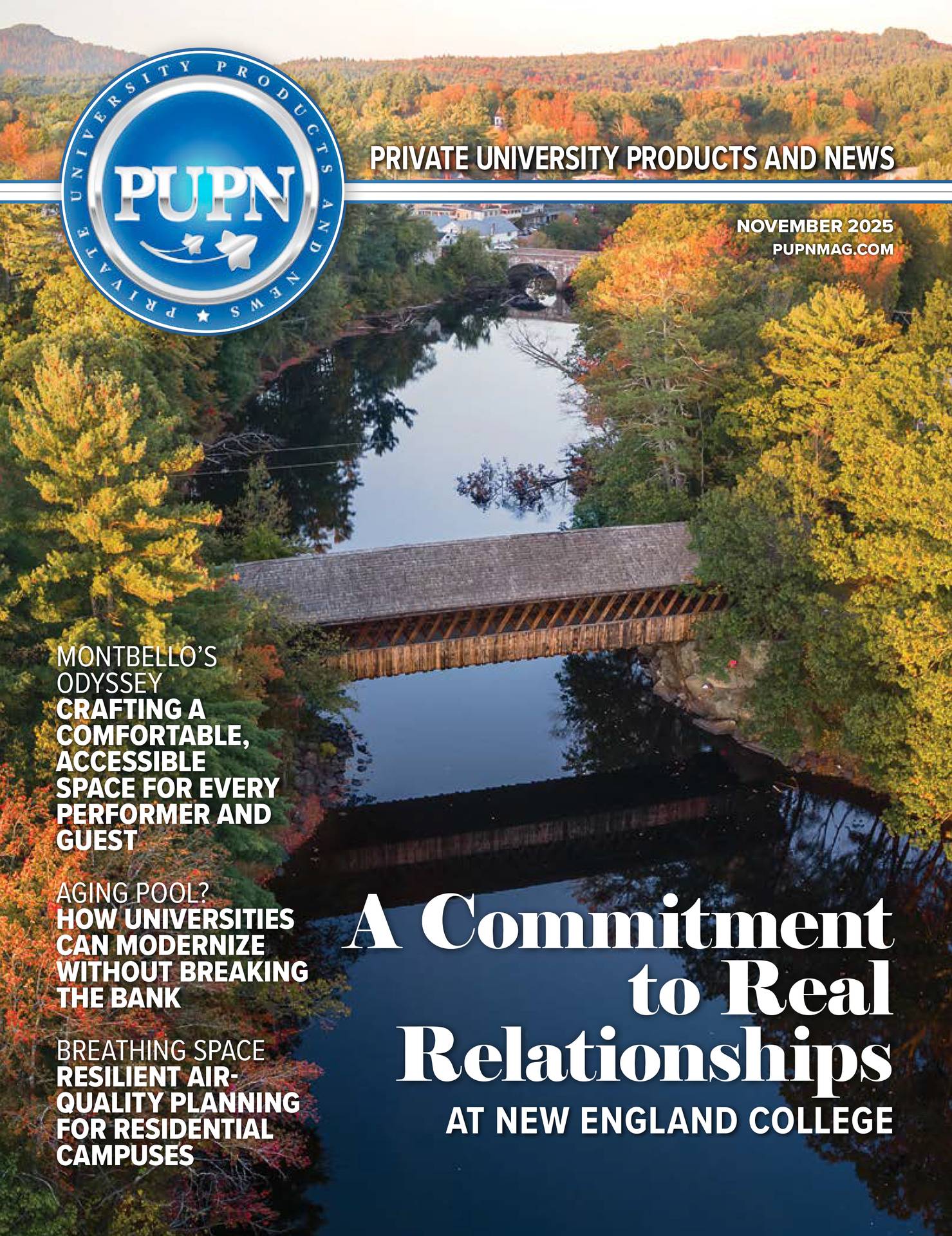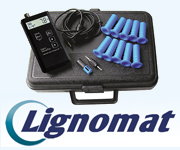Amid all its offerings, though, it’s the Patti & Allan Herbert Wellness Center that serves as a focal point of campus life. There’s a magnetic effect of the building itself, beginning with its façade: pristine design; clean lines; a bright white awning and an expansive entryway; and thoughtful, lovely fenestration. With its aesthetic vision—both inside and out—in addition to the scope of its offerings, UM’s Herbert Wellness Center is recognized as one of the finest centers in the nation for recreational sports, fitness, and wellness education programs.
The indoor facility spans nearly 20,000 square feet of cardiovascular and weight equipment, not to mention a gymnasium with multiple basketball courts that can be converted for volleyball or badminton. It also houses a smaller gymnasium with rounded walls that makes an ideal fit for indoor soccer, floor hockey, basketball, volleyball, or badminton. Students can reserve racquetball and squash courts or enjoy the indoor track.
For those who prefer aquatics, the center has a 25-yard, six-lane pool available for swimming and water exercise classes. Students can unwind with a spa and two saunas. Other amenities include a juice bar, instructional kitchen, fitness lab, studio cycling room, four multi-purpose rooms for group exercise, martial arts, and Pilates.
Really, I’m only scratching the surface of what the Herbert Wellness Center offers. The outside facilities at the center allow students to revel in the sunny weather and coastal breeze of Miami, whether relaxing or taking advantage of the four outdoor basketball courts, six tennis courts, and five intramural playing fields.
Campus Trends in Student Engagement and Wellness
I had the opportunity recently to speak with Dr. Anthony Musto, executive director of Wellness and Recreation at the university, about student engagement and wellness trends in the aftermath of the pandemic.
“I’ve noticed that students today are becoming more engaged and intentional about their physical activity,” he says. “Years ago, exercise was often driven by cosmetic goals. Now, there’s a growing appreciation for its broader benefits—especially mental health, cognitive function, and sleep quality.”
Musto sees a strong link between these trends and the experience of living through the pandemic. “I believe the COVID era played a significant role in this shift. With limited options for entertainment and socializing, many people began exercising independently and discovered how much better they felt, both physically and mentally.”
Musto describes other significant shifts in student fitness trends: “There’s been a clear rise in resistance training and a noticeable decline in traditional cardiovascular workouts,” he says. “More women are lifting weights, and there’s increased interest in free weights across the board. We recently had to renovate our fitness space to reflect this shift—our weight training area was overcrowded, while only half of our cardio machines were being used. This is a complete reversal from what we saw 15 to 20 years ago.”
Our conversation shifted to the strategies adopted by leadership to support student mental health through physical activity. “Most of our efforts focus on education, outreach, and awareness,” Musto says. “We’re working to help students understand that physical activity benefits not just the body but [also] the mind.” He cites the coordinating efforts of Wellness and Recreation with the student outreach program of UM’s Counseling Center. “[They] do an excellent job of promoting physical activity. This is especially impactful because students often seek out peer-led mental health resources—and in doing so, they are introduced to the importance of movement and self-care.” There is recognition, too, of the temptation for students to skip exercise when stressed. “We’re trying to reinforce the message that taking 30 to 60 minutes for exercise pays dividends in terms of anxiety reduction, mindfulness, cognitive function, and overall mental health.” Musto also stresses the value for students to stay active throughout the day, whether it’s walking across campus or choosing movement-based breaks.
Ensuring inclusivity and accessibility at the Herbert Wellness and Recreation Center is of umost importance to Musto. “We ensure our facility offers a wide variety of equipment to meet diverse needs. For example, we provide two lines of selectorized weight training machines, one designed for simplicity and ease of use, and another with more advanced features for experienced users. Our floor fitness staff is thoroughly trained to modify all equipment for individuals with special needs, [securing] accessibility and safety for all. Beyond the equipment itself, we offer programming at multiple levels of engagement.”
The university’s fitness-assessment program, CHAMP, is geared towards beginners. “It provides students with an initial evaluation and general recommendations to help them get started,” Musto says. “For those seeking more personalized guidance, we offer one-on-one personal training. And for students who thrive on competition, we host a variety of fitness challenges throughout the semester to keep them motivated and engaged. All our fitness professional staff have degrees in exercise physiology, so they are always available to assist those that might need some more technical advice or specific needs.”
Musto notes the university measures the success of its fitness and recreation programs by tracking both total participations and unique participants. “In Spring 2025, we welcomed approximately 13,000 unique students into our facility—representing roughly 65 percent of our total enrollment. While our undergraduate population is around 13,000, they make up the majority of our users. For our educational programs, we also assess knowledge outcomes. We want to know: Did students actually learn what was intended during the presentation or assessment?” He uses the CHAMP fitness assessment as an example: “After completing [the assessment], students receive a follow-up questionnaire that includes knowledge-based questions to gauge learning. Ultimately, that’s what matters most—not just physiological outcomes, but whether students gained insights that support their long-term health and well-being. This year, we began analyzing data from club sports and intramural participation to explore their impact on retention and GPA. In both cases, we saw a positive effect. Notably, club sports participants had a 100 percent retention rate from Fall 2023 to Fall 2024. That’s not surprising, given the level of commitment required to be part of a club sport.”
My final question for Musto concerned any recent challenges faced by leadership and how these were addressed to better serve students. A central challenge, he notes, is related to space: “As the university continues to grow and interest in exercise increases, nearly every area of our facility experiences high traffic—including the fitness room, tennis courts, basketball courts, and intramural fields,” he says.
“Our main challenge is finding ways to operate efficiently while meeting the needs of our members and making the best use of the space available. So far, we’ve repurposed two racquetball courts: one now serves as a functional training area, and the other has been converted into a stretching zone. Relocating the stretching area freed up valuable space in the fitness room, allowing us to add more resistance training equipment. We have repurposed a pool office to make space for a cold plunge and recently upgraded our saunas. What we can do with space we are trying to make up for with ‘bells and whistles’.”
With the commitment of Musto and his capable team, the University of Miami aspires to make student enthusiasm around holistic wellness the norm so prospective and current students alike can look forward to conditioning both mind and body at the Herbert Wellness Center.










